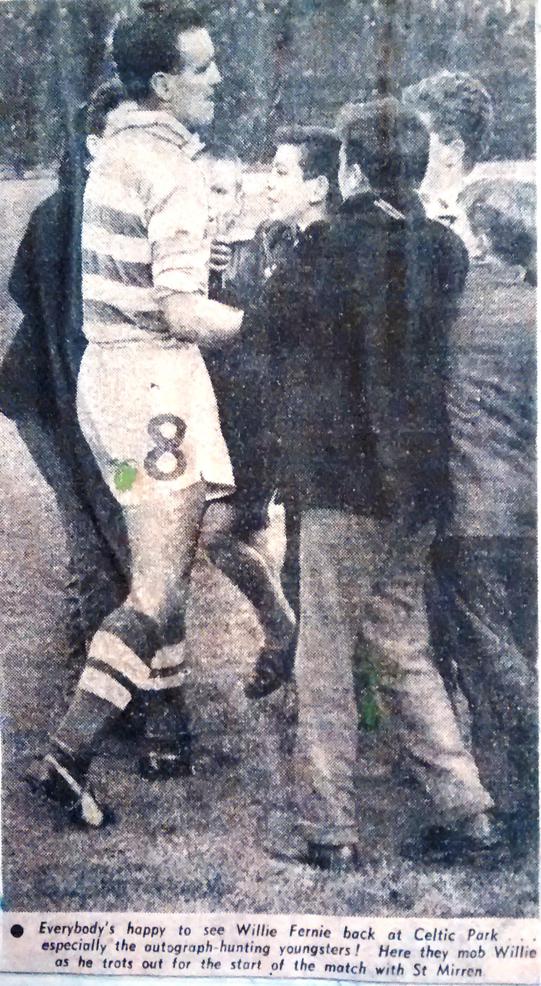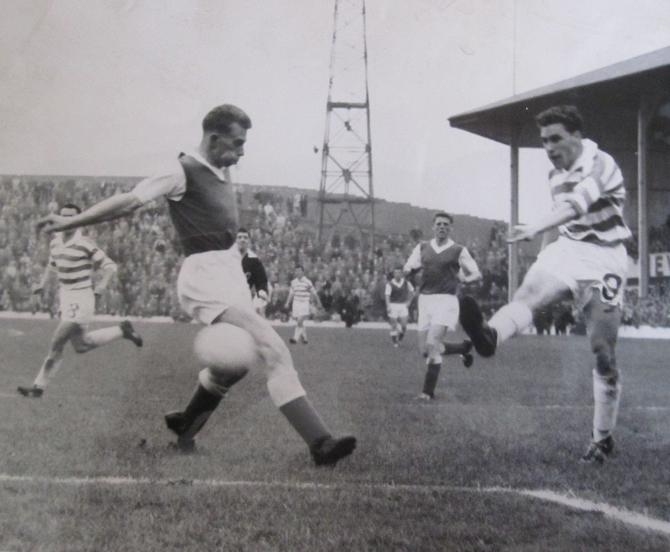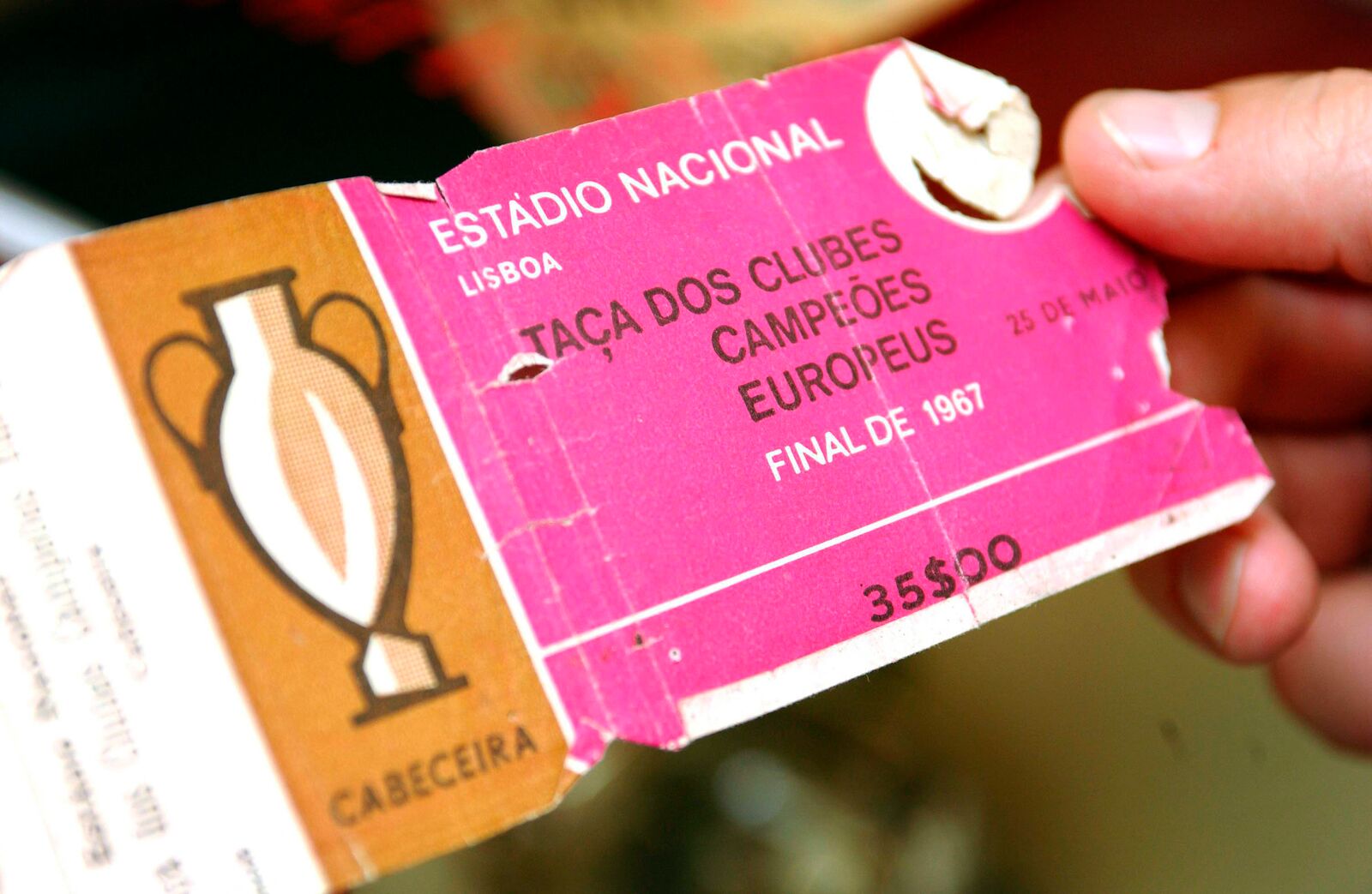Although it was now summer football was still the main game in the streets. We did occasionally play a form of rounders but cricket was an alien idea. Now that we had TV we could watch Wimbledon and for a week or so our street became a tennis court. We fashioned racquets out of bits of wood and the conveniently sited cracks in the road formed the boundary lines. However such pastimes as these were temporary distractions. Football was the only game that really mattered.
And yet when the 1960/61 season started I was only vaguely aware of the fact. It was already a few weeks old when I noticed from the back pages of the Sunday Post that football was back in swing. I started to keep a scrapbook using photos that caught my eye in the Daily Record, Sunday Mail and the Sunday Post. Those newspapers along with the Sunday Observer were delivered to our door but that newspaper did not seem to have as much photos and the reports were a lot longer and used bigger words than in the other papers.
In addition to those deliveries we got the Irish Weekly every Sunday but that paper only seemed to mention 2 teams – Celtic and, to a lesser degree, Hibernian. These were fascinating names but so too were the likes of Queen of the South, St Johnstone, Albion Rovers, Airdrieonians, Heart of Midlothian. At that stage I had not yet identified myself solely with Celtic.
Those were more competitive times in Scottish Football. Teams like Aberdeen, Dundee, Motherwell, Hearts, Hibs, Clyde, St Mirren and even Falkirk were winning leagues and cups and many sides had international players. Although I went to a Catholic school only a few miles from Celtic Park my school mates claimed allegiance to various teams mainly because they had had more recent success than Celtic.
They were not actually going to the likes of Shawfield or Love Street or Fir Park but they identified with this teams who seemed more likely to win than Celtic. A few years later when Jock Stein arrived most of those boys would be on the terraces at Celtic Park.
The name Celtic was the one that did seem to crop up the most often though when I eavesdropped in on the adults discussions at the granny’s place every Sunday. The earliest memory I have of paying attention to a Celtic result was in the Sunday papers of 2 October 1960. The headline caught my eye – “Storrie book ending for Diamonds”
It told how Jim Storrie had scored in a 2-0 win for Airdrie over Celtic at Broomfield. A few days later came the moment that I remember as the first time I really took an interest in Celtic. My best friend at the time – Peter Dickson – was a Celtic fan and he told me excitedly that Willie Fernie was returning to Celtic. I did not know who Willie Fernie was or that he had even left Celtic in the first place but Peter’s enthusiasm rubbed off on me and on Saturday 8 October along with Peter we sought out the Celtic score as soon as we could.


A 4-2 win over St Mirren at Celtic Park. My Celtic supporting life had got off to a great start. It was even better the following week. Peter’s father – Danny Dickson – was involved in running the St Bridget’s Boys Guild team and on Saturday 15 October they had a big game away to the other top Boys Guild team of the time – Viewpark St Columba’s.
After the game we got on the team bus to take us back to Baillieston. The radio was on and we heard that Celtic had won 6-0 against Hibs at Easter Road. That night was the first time I recall seeing a Celtic game on TV. “Scotsport” had highlights of the game from that afternoon including an overhead kick goal from Stevie Chalmers.

Now I was really hooked and every Saturday would seek out the Celtic score. As far as watching football was concerned though that was mainly done at Maxwell Park with the Boys Guild. My first football “heroes” were guys like goalkeeper Jimmy McCarthy in his red sweater and centre forward Malky McKay. Peter Dickson and I often gave a hand to the running of the team. On Friday nights we would put “dubbin” on the balls and on Saturday mornings we would go down to a local woodworker and pick up a bag of sawdust.
This was then used to line the pitch for the afternoon’s game. In those days football was still the major form of entertainment for many people and even amateur games could attract a big crowd. It was not unusual to see at least one side of Maxwell Park full of spectators when the Boys Guild team was playing.



